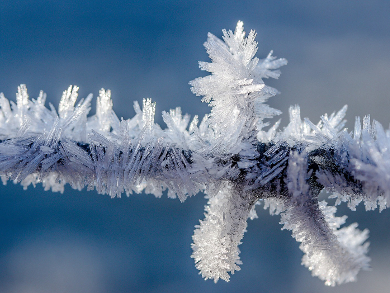Ice formation is a problem in many aspects of daily life, from frozen windshields to airplane wings. Deicing methods are usually either time- or energy-extensive. Superhydrophobic surfaces (those with a so-called “lotus effect”) can sometimes prevent ice formation by repelling liquid water before it freezes. However, at very cold temperatures, ice can form directly from water vapor without liquid water as an intermediate step. Superhydrophobic surfaces cannot prevent this process.
Ming-Chang Lu, National Chiao Tung University, Hsinchu, Taiwan, and colleagues have developed a process to control where exactly ice forms on a surface, which keeps other areas ice-free and makes de-icing easier. The team created V-shaped microgrooves on a silicon surface using etching to make it “rougher” in a controlled manner. This causes ice crystals, formed from water vapor at temperatures between –25 °C and –9 °C, to only nucleate at the grooves. This keeps the ice spatially contained, which was observed by the researchers with an environmental scanning electron microscope (ESEM).
The effect is caused by lowering the free energy barrier for nucleation along the grooves. The team could also use the shape of the microgrooves to control the stacking direction of the formed ice crystals. In a V-shaped groove, the ice crystals stacked neatly along the direction of the groove, in a groove with a trapezoid cross-section, the ice crystals grew in random directions. The team compared the deicing properties of the surfaces with V-shaped grooves with a plain silicon surface and found that the grooved surface was largely deiced much faster than the plain surface, which is randomly covered with ice crystals.
- Control of Ice Formation,
Ching-Wen Lo, Venkataraman Sahoo, Ming-Chang Lu,
ACS Nano 2017.
DOI: 10.1021/acsnano.6b07348

![Synthesis of [c2]Daisy Chains via Mechanochemistry](https://www.chemistryviews.org/wp-content/uploads/2025/04/202504_RotaxanesWithSolidStateMechanochemistry-125x94.png)

